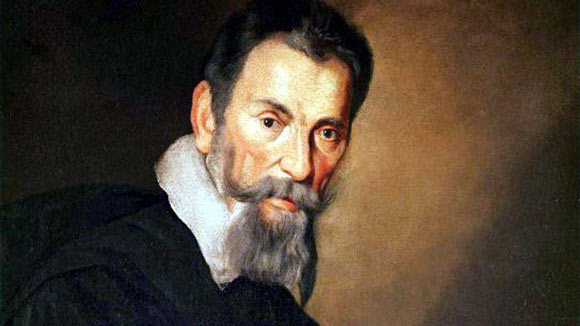
Claudio Monteverdi was an Italian composer and a Roman catholic priest. He is often credited with bridging the gap between the music of the Renaissance and the music of the Baroque period.
Claudio Giovanni Antonio Monteverdi was born on a date unknown to historians, although it is known that he was baptized on May 15, 1567 in the Italian District of Lombardy. While he was only a child, he would occasionally visit Marc’Antonio Ingegneri, who was the maestro di cappella at Monteverdi’s hometown cathedral, the “Cathedral of Cremona”. Ingegneri gave Monteverdi his first lessons in music and composition; he also urged Monteverdi to take part in the cathedral choir.
In 1582, Monteverdi published his first work, a collection of motets titled Sacrae cantiunculae. He followed that up with a sacred madrigal titled the Madrigali Spirituali in 1584, a collection of three voice canzonettes in 1584, and a five part madrigal in 1587. He then graduated to music director for the court of Mantua after playing the violin for them. By 1602, he was court conductor for the court of Vincenzo I of Gonzaga in Mantua. In 1613, he moved to St. Marks Basilica and worked there as a conductor, he was credited for ‘rescuing’ the standard of music there, since it was completely devoid of creativity before Monteverdi’s arrival. By 1632, Monteverdi became a priest of the Roman Catholic Church.
Monteverdi’s early works consisted of his madrigal books. Monteverdi wrote nine Madrigal books in total. Of those nine, the Fifth Book of Madrigal, the “Quinto Libro”, was known for exemplifying the evolution of late Renaissance music to early Baroque music. Monteverdi’s eighth madrigal book, which he finished in 1638, was his largest. The eighth madrigal book was also known to have works written over a thirty year time period. Interestingly, Monteverdi chose to divide his book into sections of “War and Love”.
Monteverdi wrote plenty of operas, around eighteen in number, however, he is known for two in particular. One of them was titled “Il ritorno d’Ulisse in patria” (translated as “The Return of Ulysses to his Homeland”). Il Ritorno focused on the story of the King of Ithaca, and it was based on the victory of patience over treachery, and hence the ultimate victory of good over evil. The opera was so successful that it was performed over ten times in the Venice Carnival of 1639-1640. The other opera was called “L’incoronazione di Poppea” (translated as “The Coronation of Poppea”), and it was based on the Roman Emperor Nero. This opera was so grand that when it was performed in the Venice Carnival in 1642-1643, it was in a setting that housed 900 people, yet the stage was larger than the auditorium.
Monteverdi’s most famous church music was a collection of scores called the “Vesper Psalms” of 1610. He also wrote a mass of thanksgiving in 1631. Claudio Monteverdi passed away of November 29, 1643 in Venice. His music has received recent interest in the 1960’s, and many of his works were rediscovered and performed since then.